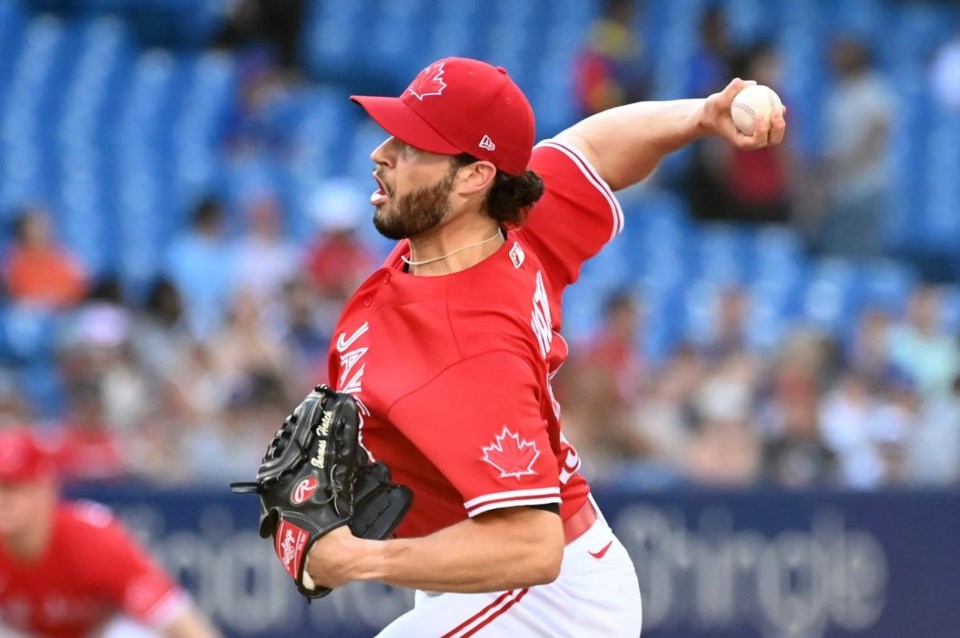DUNEDIN, Fla. — Blue Jays pitcher Thomas Hatch had a first-hand look at some of baseball's rule changes when he was in the minor leagues last season.
By far the biggest difference for the right-hander was pace of play.
"Our games would start at 7 p.m. and we'd be out by 9:30 just about every night," he said Wednesday. "Three-hour games would seem like an eternity. It took a little bit to get used to that but it was a good thing."
Several rules implemented at lower levels in recent years will be used in the big leagues this season. Shift restrictions will be in place, pitch clocks will be used, bases will be larger and there will be pickoff attempt limits.
Major League Baseball is hoping for a quicker, safer, more exciting product by making what it calls the most significant rule alterations in decades.
"I think overall it's going to be good for the game and good for the fans," said Blue Jays manager John Schneider.
MLB executives were on site at TD Ballpark on Wednesday afternoon to deliver a slideshow to media members and provide on-field demonstrations. The pitch timer is considered to be the biggest change.
Batters and pitchers will have to get ready quicker. If they're not on time, they could be charged with an automatic ball or strike.
In addition, infielders can no longer load up on one side of the diamond or move into the shallow outfield. At least two infielders must be completely on either side of second base or risk the penalty of an automatic ball.
"I love it," said Blue Jays shortstop Bo Bichette. "I think that there were shifts for a good reason obviously with numbers and knowing a little bit more about players' tendencies and stuff like that.
"But I don't really know if the game was meant to be played that way."
The new bases will be 18 inches (45.7 centimetres) on each side, up three inches (7.6 cm) from before. Injury prevention by minimizing player contact is one potential benefit and more aggressive base-running is another.
"I was planning to be more aggressive anyway but obviously I guess it's going to be easier with those rules and pickoff (limits) and all that," Bichette said. "So that'll be something that we have to learn and see what we can take advantage of there."
The changes will be in effect for the start of Grapefruit and Cactus League play this month. The Blue Jays open their pre-season schedule on Feb. 25 against the Pittsburgh Pirates.
Expect an adjustment period as umpires, timers, pitchers, hitters, managers and coaches adapt to the implementation.
"Guys get used to a certain cadence of their game and their routine," Schneider said. "That's going to be a little bit different. So we've built in some constraints for spring."
The Blue Jays' big-league staff also had regular off-season interactions with the club's minor-league coaches and players to discuss the nuances of the rules and adjustments that were required.
There have also been discussions on what to expect from opposing teams across MLB since some teams have different styles than others.
There will be strategy in play on timing routines, leadoff styles and false breaks. To get around shift restrictions, some clubs may bring an outfielder closer to the infield.
"New is different and it's going to take a little bit of time," Schneider said.
Infielder Addison Barger, a sixth-round Blue Jays' draft pick in 2018, has seen it all after playing Single-A, Double-A and Triple-A last season.
"It's definitely more hurried but it does makes a pretty big difference with pace of play," he said. "The pitch clock gets annoying but it's part of it.
"It moves the game along. You get used to it after a couple (at-bats). It's fine."
Hatch said it took him about a month to get used to the timer.
"I think it takes a little bit of the thinking aspect out of it, which can be good and can be bad for some people," he said. "I think some people are more methodically thinking while they're pitching.
"I think some people are just more physical and just like to go out and throw the ball."
There will be 30 seconds between batters and two minutes 15 seconds between innings. When runners are on base, pitchers will have 20 seconds to deliver their pitch and just 15 seconds when the bases are empty.
""When you implement anything new, there's some adjustment and some getting used to it and maybe some complaining here and there," Hatch said.
"But I think once everybody acclimates to it, it'll be a good thing."
This report by The Canadian Press was first published Feb. 15, 2023.
Follow @GregoryStrongCP on Twitter.
Gregory Strong, The Canadian Press




